Birchburn Cottage, Seton Terrace (destroyed in Skelmorlie’s reservoir disaster)
 The 1910 Ordinance survey shows the site of Birchburn cottage, house and stables. The property lies to the east of Seton Terrace and north of Halketburn and Halketburn Road.
The 1910 Ordinance survey shows the site of Birchburn cottage, house and stables. The property lies to the east of Seton Terrace and north of Halketburn and Halketburn Road.
As far as we are aware there are no surviving pictures of Birchburn before it was destroyed.
| Owners | Dates | Alterations |
|---|---|---|
| Mr James Hamilton | c. 1881 – c.1893 | Land purchased from the Earl of Eglinton and Winton and Birchburn Cottage, stables and house built. |
| Mr John & Mrs Marion Dallas | c.1893 – 1921 | |
| Mr Sandy and Mrs Emily Dallas | 1921 – 1925 |
The early years – 1880s.
The earliest mention we’ve found of “Birchburn” is in the 1891 census. This tells us that there were 3 properties with the same name, all beside one another. [1]
The first was a 3-room cottage occupied by 69-year-old Catherine McDougall. Catherine was a spinster, born in Inverary who lived on her own and off her own means. [1]
Next door was another 3-room cottage. The head of this household was 54-year-old Murdoch McDonald, a gardener born on Jura. Living with him were his 3 children: Mary Ann McDonald, aged 17, a housekeeper, Mary Jane McDonald, aged 14, a scholar and a son Murdoch Angus McDonald, aged 12, also at school. All three children were born locally. Also living with the family was Mary Malcolm, an 80-year-old spinster born on Jura, whose occupation was given as accountant. [1]
The third property had one room which was occupied by Margaret Cameron a 24-year-old dressmaker from Edinburgh. [1]
According to the census, James Hamilton, a 54-year-old coal merchant, born in Ireland lived next door to Birchburn in the 11-roomed house, Glendhu together with his 55-year-old wife Helen, born in Killin in Perthshire. [1]
Interestingly, we find from the 1885 valuation roll (i.e., 6 years earlier) that James Hamilton is not only the owner of Glendhu, but also the next-door stables, coach house and house (this is almost certainly Birchburn). In 1885 these three properties were unoccupied and didn’t appear at all in the earlier 1881 census. [1][2]
Authors Note: We know that later owners of Birchburn were not only carriage hirers but also delivered coal locally. It’s therefore likely that James Hamilton, coal merchant moved to Skelmorlie in the early 1880s and built not only the coal yard and attached buildings, i.e., Birchburn, but also a house for himself and his wife, Glendhu.[1][2]
James and his wife did not stay in the village long. By 1895, Birchburn had a new owner, John Dallas and the name Glendhu had disappeared. [1][2]
So, what happened to Glendhu? It’s our belief that Glendhu was just an earlier name for Invereoch, at 1 Halketburn Road. This is based on Invereoch being a direct neighbour of Birchburn, the right size (11 rooms) but also in 1891 (census) there is mention of Glengyron (occupied by the Vallance sisters), Birchburn (empty), Glendhu (the Hamiltons) but not of Invereoch. In the subsequent 1895 valuation roll there are listings for Glengyron (Vallance sisters) and Birchburn (Dallas), Glendhu disappears and Invereoch (Arnott) appears. [1][2]
c.1893 – 1921 Mr John & Mrs Marion Dallas
John Dallas was born in Govan in 1846 to John Dallas, cashier, and Margaret (Shields) Dallas. He married Marion Niven in 1869 in Oban, when he was 22 and a boiler maker and she was 19. Marion was the daughter of Alexander Niven, a plasterer and Margaret (Niven) Niven. [3]
After the wedding they moved to 61 Merkland Street, a 5-storey tenement building in Partick, where they gave birth to their first son John (Jnr) Dallas, later that year. [3][4][5]
Two years later (1871 census), the family was still at Merkland Street. John was 25 and working as a boilermaker, Marion was 20 and John (Jnr) was 1. Living with the family were Jane Niven (28), and Georgina Niven (18), both sisters of Marion who gave their occupation as sewing machinists. [4]
By 1881, the family had moved to a 3-room apartment at 31 East Crawford Street in Greenock, not far from James Watt Dock and East Cartsdyke railway station. By that time, John was 34 and a rivetter (foreman), Marion was 31 and John (Jnr) was 11. The couple had had two further sons: James Niven Dallas born in 1871 and Alexander Niven Dallas, born in 1873. There had been another boy child, George Moir Dallas born in 1877, but sadly, he’d died aged just 18 months. Also living with the family was Cathy Niven (23) a sewing maid born in Oban who was visiting at the time. Cathy was most likely a relation of Marion’s (same surname and birthplace). [3][4][5]
Ten years later again (1891 census), the family were living in a 3-room flat at 18 Helen Street in Govan. John was 45 and a ship rivetter as was John (Jnr) who was 21. Marion was 41. James was 19 and had become a marine engineer. Alexander who was 16, was an apprentice ship plater. The family had expanded again, with the birth of Marion Niven Dallas (Jnr) in 1882 and George Niven Dallas born in 1886. [4][5]
Some time over the next couple of years, John Dallas gave up the shipyards and purchased Birchburn Cottage and offices in Skelmorlie.[2]
From the subsequent 1901 census we see that Marion (his wife) and the three youngest children (Alexander, Marion (Jnr), and George) moved with him. John’s new occupation was carriage hirer (employer), telling us that he owned the business. His son Alex known as Sandy, then 26, was working with his father and gave his occupation also as carriage hirer. Marion (Jnr) was 18 and George was 14 and still a school. Also living with the family was James Bradley (21), a general carter working for John. [6]
Ten years later (1911 census), John (64) and Marion (63) were still living at Birchburn. Living with them were their sons Sandy (36) now a partner in the carriage hiring business and George (23), a cab driver. [6]
In July 1912, John Dallas died at home, aged 68. [3]
Just a few months later, George then 25, married Catherine McBroon, a domestic servant, aged 24, living and working next door at Invereoch. [3][7]
In October 1914, it was Sandy’s turn to get married. He wed Emily Menhennet aged 34, a domestic servant who was living and working at Heywood. Emily’s father was William Thomas Menhennet, a Blacksmith and her mother was Elizabeth (Outhwaite) Menhennet. The wedding took place in Govan in Glasgow, presumably at her parent’s house. [7]
At the time of the 1915 valuation roll, Birchburn was listed as 3 properties: Birchburn cottage (the largest) and two smaller properties, a house and stables. Sandy Dallas was listed as occupier of the cottage and the other two properties were empty. The three properties were owned by John Dallas’s estate which was being executed by Marion Dallas then living at Lorne Cottage. [8]
Five years later, the estate was settled, and Marion Dallas had inherited the three properties. Sandy and Emily were living in the cottage and Marion was listed as living in the house and stables. [8]
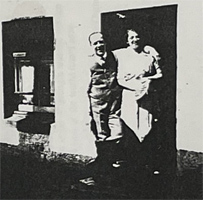
Sandy & Emily standing at the door of Birchburn cottage. Source: Largs Museum
1921 – 1925 Sandy & Emily Dallas
By 1921, Sandy was 47 and still living in the 4 roomed Birchburn cottage. His occupation was then carting contractor, showing the evolution of the business as cars took over from horse and carriage. Living with him was his wife Emily, 41 and his mother, Marion aged 72. By this time, Sandy and Emily had three children of their own: Elizabeth born 1916, aged 5, Alexander born 1917, aged 3, and Frederick/Freddie born 1920, aged 1. [6]
Living at the house /stables next door was Sandy’s younger brother, George (34) also carting contractor. His wife Catherine was 33 and like Sandy & Emily, the couple also had three children: Janet aged 8, May aged 5 and George a new-born 1921.[6]
Later the same year Marion Dallas died at home of ‘old age’. [3]
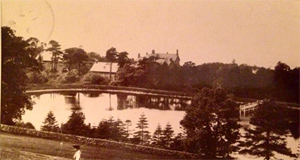
Skelmorlie Lower Reservoir circa 1910. Source: Facebook SK & WB in their heyday
Sandy and his family were still living at Birchburn cottage in 1925 when the Skelmorlie Reservoir Disaster tragically took the lives of two of their children Alexander and Freddie as well as their niece Winne. [9]
Author’s Note: The details of the disaster and the impact on the Dallas family below are taken from an account of the Skelmorlie Reservoir Disaster, written by Wilma Menhennet Davidson, niece of Winne Menhennet.
Wilma prefaces her account by saying she first heard about the tragedy when she was a child. Her father told her about how his 8-year-old sister and two boy cousins had died when the reservoir above the village, burst its banks and 3.5 million gallons of water flooded down to the shore in the space of ten minutes.
The following account focuses on what happened at Birchburn cottage, the full story can be found at Skelmorlie Reservoir Disaster
“On Saturday 18th April 1925 it was extremely wet and stormy with a very high wind from the north. In the yard of Birchburn cottage, Sandy Dallas was preparing his horse and cart for that morning’s coal deliveries around the local farms and villages. His cottage, Birchburn, was situated alongside the Halketburn which served as an overflow from the reservoir. The burn descended steeply through a deep glen behind his property, flowing through his coal yard and alongside his cottage. The three railway men who were his lodgers had already left for their early morning shift at Wemyss Bay station. In the cottage were his wife Emily, his daughter and two sons, & their cousin Winifred aged 8.
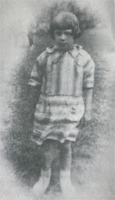
Winnie Menhennet
Winnie Menhennet was on holiday from Glasgow. She was a frequent visitor, but on this occasion, she had been suffering from a bad bout of measles and had been sent to stay with her relatives in Skelmorlie in the hope that the fresh sea air would help to speed her recovery. She had been due to return home the previous day, but because the weather had been so awful, keeping the children indoors for much of their Easter holiday, the family decided that she should remain in Skelmorlie for a further week ….. a fateful decision.
Skelmorlie endured the dreary boredom of a wet Saturday morning. In homes all over the village, breakfast dishes were cleared away, and children played indoors, watching the rain coursing down the windowpanes, and leaving deep muddy puddles all around. A few people plodded through the torrential rain with shopping baskets. The morning wore on wearily, Sandy Dallas continued his round of deliveries. As the clock moved on families sat down to lunch. Elizabeth Dallas, known as Lizzie, who was 10 at the time, was sent to the shop for milk and eggs. She trudged out into the rain, complaining loudly.
At around two o’clock a family living about fifty yards below the reservoir (Glengyron) heard a loud crack and noted with alarm that two fissures had suddenly appeared in the embankment, and water was starting to seep out. A few seconds later the embankment gave way along a 30-foot length under the tremendous pressure of the water, and the flood suddenly surged with awful force down the steep slope on which the village is built.
At Birchburn Cottage Emily Dallas heard the noise of the first escape of water, and rushed outside to see what was happening. She saw immediately that the overflow from the reservoir had suddenly and dramatically increased. She got the children outside, with the intention of warning the occupants of Taymouth House,slightly downhill from her own house, that water was escaping from the reservoir. She called on the children to follow her through the flood, but frozen with fear, they hesitated. At this moment a second great burst of water came thundering down with terrible force. She watched in horror, helpless as her home, and the three children were swept away.
James Robertson of Mount Pleasant had seen the avalanche of water strike the cottage and ran down through his garden to try to help. Sandy Dallas and a local farmer, John Paton, climbed onto the precarious corrugated iron roof of the stables behind the house, with the flood waters swirling around them, to try to locate the missing children. All three men were soon wading waist deep in the fast-flowing water, endangering their own lives, but to no avail.
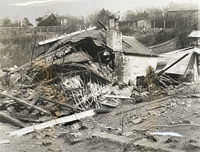 When the torrent had passed the scene in the village was one of utter devastation. A great chasm could be seen where the reservoir embankment had collapsed. Trees and shrubbery were uprooted and strewn all over the place. Deep fissures were torn in the roadways at several places, and Birchburn Cottage was completely demolished. What had been a happy family home only fifteen minutes before was now a shattered ruin, with not one wall remaining. Only the tiled grate remained standing in the centre of the cottage, and part of the stables at the back. The family’s furniture and belongings were scattered all down the hillside, describing the course of the torrent.
When the torrent had passed the scene in the village was one of utter devastation. A great chasm could be seen where the reservoir embankment had collapsed. Trees and shrubbery were uprooted and strewn all over the place. Deep fissures were torn in the roadways at several places, and Birchburn Cottage was completely demolished. What had been a happy family home only fifteen minutes before was now a shattered ruin, with not one wall remaining. Only the tiled grate remained standing in the centre of the cottage, and part of the stables at the back. The family’s furniture and belongings were scattered all down the hillside, describing the course of the torrent.
After the event, a terrible silence descended on the village, as the shock of what had occurred gradually dawned. People quickly round and in a desperate attempt to try to find anyone alive, willing hands shifted debris and men waded waist deep in the muddy waters. Sadly, early optimism turned to sorrow, as the victims of the disaster were found one by one.
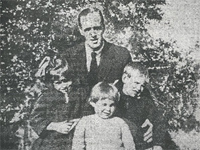
Winnie Menhennet (left) Freddie Dallas (right) with Winnie’s father (back) and her brother Willie (front).
Winifred Menhennet was found in the flood waters, caught on a bank, by Captain Scott and the manager of the hydro, Mr Campbell. They waded into the flood to retrieve the little girl. She was dead. Her skull had been fractured.
Freddie Dallas, aged 5, was found dead a short distance from his home.
Alex Dallas, aged 7.5, was carried half a mile right down to the shore and swept into the sea at high tide. His body was discovered only when the tide went out. He was half buried in the sand.
Beside him, motionless was his faithful dog, which had been swept away with him. Alex and the dog were constant companions. When they were discovered, a neighbour lifted the dog and took him to his own house, not wishing to burden the family further. Later that same evening the dog revived, having been knocked unconscious but still alive. He was returned to the family the following morning.
Lizzie Dallas survived the disaster which killed Winnie and her two brothers only because she had been sent to the shops and was away from the house when the flood occurred.” [9]
The funeral service for Alexander Dallas, Freddie Dallas, and Winnie Menhennet, was held on Wednesday 22nd April at Ochiltree and conducted by Rev. Macaulay of the North Church together with the minister of the Menhennet family’s Methodist Church in Glasgow. [9][10]
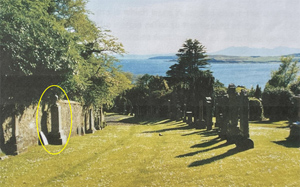
Largs cemetery – Dallas gravestone on left. Source: ND 2022
It was a simple and stirring service attended by many Skelmorlie residents. Outside the local boy scouts, girl guides, and school children assembled to pay tribute to their dead friends. There was also a large gathering of mourners from the village. The children’s coffins were covered with beautiful wreaths and other floral tributes, a few of which had been brought by the children’s friends. One of the motor coaches was also filled with flowers.

Gravestone for the Dallas boys and cousin.
The internment of the three children was at Largs Cemetery and marked by the gravestone shown. [9][11]
The wording on the gravestone reads: “ALEXANDER NIVEN DALLAS IN LOVING MEMORY OF HIS SONS ALEXANDER NIVEN DALLAS IN HIS 8TH YEAR FREDERICK IN HIS 6TH YEAR ALSO THEIR COUSIN WINNIFRED MARY MENHENNET IN HER 9TH YEAR WHO LOST THEIR LIVES IN THE SKELMORLIE RESERVOIR DISASTER 18TH APRIL 1925. O Rest in the Lord”
.
.
.
What happened to the family?
Wilma Menhennet Davidson wrote the following postscript:
“Following the disaster, a fund was started locally to help the family, who’d lost not only two of their children and their niece but their home, business, and all their possessions. Enough money was collected from a very generous local community to set Sandy Dallas up in business in a local greengrocer shop, where he remained for some time.
However, he was haunted by the events of the disaster, and being unable to settle, he decided to move to Glasgow with his wife and daughter and found work in a shipyard.
He was tragically killed in an accident at work on 23 July 1929.
His widow and surviving daughter Lizzie lived on in their house in Clifford Street, Ibrox, but fate had another cruel blow for the family. Emily Dallas died in 1933, at the age of 53. This left Lizzie alone in the world at the young age of 18.
At first Lizzie went to live with her aunt and uncle, Nellie and William Menhennet in Craigton, Glasgow, but was unable to settle and moved away to live and work in Paisley. In due course she married Bill White, a caretaker and janitor. They had no children.
Despite her unfortunate family history, Betty (as she was latterly known) was always cheery, talkative and a great friend.” [9]
Betty White (Elizabeth Menhennet) died in 1978, aged 62 in Paisley. [7]
Authors Note: Sandy and Emily Dallas were buried beside their two children and niece in Largs cemetery. The same gravestone, albeit a different face was updated with their details.
“ALEX NIVEN DALLAS ACCIDENTALLY KILLED AT FAIRFIELD SHIPYARD, GOVAN, 23rd JULY 1929 AGED 54 YEARS. EMILY MENHENNET WIFE OF ABOVE DIED 26TH AUGUST 1933 AGED 53 YEARS”.
At the foot of the gravestone, on the right, is a small plaque placed there by Sand’s workmates from Fairfield shipyard in Glasgow. [9]
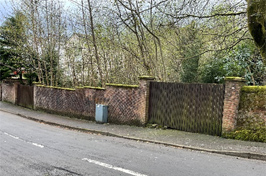
Present
The site of Birchburn cottage, stables and house was cleared and as far as we know, stayed empty, although a brick wall and gateways were constructed around the site. Today, the gateways remain boarded over and the land enclosed left to go wild. For a while this area of Skelmorlie was known locally as “Dallas’s corner”. [9]
The ground to the north and adjoining Birchburn cottage and stables on Seton Terrace was an orchard when the Dallas family lived there. Today it’s the site of a row of white modern houses. [9]
Sources and References:
[1] 1881, 1891 censuses (Skelmorlie)
[2] 1885, 1895 and 1905 Valuation rolls (Skelmorlie)
[3] Birth, death, and marriage certificates for John Dallas and family.
[4] 1871 census (Partick), 1881 census (Greenock) and 1891 census (Govan)
[5] Google Maps – Partick, Greenock and Govan
[6] 1901, 1911, and 1921 censuses (Skelmorlie).
[7] Birth, death, and marriage certificates for Alexander Dallas and family.
[8] 1915,1920 and 1925 Valuation rolls (Skelmorlie)
[9] The Skelmorlie Reservoir Disaster by Wilma Menhennet Davidson
[10] The Glasgow Herald: Monday April 20th, 1925- Hillside reservoir bursts
[11] The Largs and Millport Weekly news, Saturday April 25, 1925
